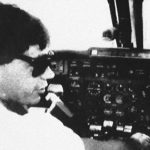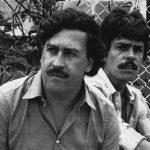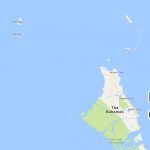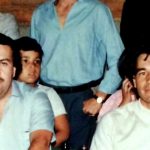Meet Hitler-obsessed drug smuggler
 Meet the cocaine-addled, Hitler-obsessed drug smuggler who tried to take down Pablo Escobar
Meet the cocaine-addled, Hitler-obsessed drug smuggler who tried to take down Pablo Escobar
By Christopher Woody From Business Insider
Pablo Escobar is remembered as the face of the Medellin cartel, the Colombian criminal organization that flooded the world with cocaine in the 1980s.
But for all his deeds and bluster, Escobar was just one member of a clan of traffickers who helped create the Medellin cartel.
And in terms of narco eccentricities, one Medellin capo stands out: Carlos Lehder Rivas.
Born to a German father and Colombian mother in Armenia, a district in west-central Colombia, in 1949, Lehder spent most of his childhood in Colombia.
But after his parents separated, he relocated to New York City when he was 15, Colombian newspaper El Espectador reported in 2012.
In the US, he got involved in petty crime, working on the US East Coast and in Canada leading a stolen-car ring and moving marijuana. He got picked up for car theft in June 1973 and was sent to federal prison in Danbury, Connecticut. His brief stint in jail would forever alter the US and the world.
George Jung, the now famous drug smuggler and subject of the movie “Blow,” was Lehder’s cell mate and described the Colombian-American as well mannered and well dressed. As Jung told PBS, even while locked up for minor crimes, Lehder had his mind on a more ambitious criminal enterprise:
“As time wore on, we got to know each other and then he asked me if I knew anything about cocaine and I told him no. And I said, ‘Why don’t you tell me about it.’ And he said, ‘Did you know it sells for $60,000.00 a kilo in the United States?'”
“And I said, ‘No. I had no idea. How much does it cost down in Colombia?’ and he said, ‘$4,000 to $5,000.’ And immediately bells started to go off and the cash register started ringing up in my head.”
“It was like destiny” that Jung and Lehder ended up together at Danbury, Mike Vigil, a former chief of international operations for the Drug Enforcement Administration, told Business Insider.
Jung and Lehder were released in the late 1970s, but they soon hooked up again, setting up an airborne-smuggling operation that moved cocaine from Colombia to the southeastern US.
As their operation expanded in the late ’70s and early ’80s, Lehder grew closer to the capos back in Medellin, and in the Caribbean, they looked for a way station for their bustling trafficking business.
‘It just turned into a freak show’
Norman’s Cay Bahamas George Jung Carlos Lehder Medellin cartel drug cocaine smuggling
Norman’s Cay, about 200 miles from Miami, became a major smuggling hub in the late 1970s. Google Maps
“They used to smuggle drugs through Nassau, Bahamas, by using corrupt officials that would open up the airport and look the other way … But they wanted a more isolated area — an area where they could operate more freely and not have to pay a ton of Bahamian individuals,” said Vigil, author of “Metal Coffins: The Blood Alliance Cartel.”
“So that’s when they came out to Norman’s Cay,” he told Business Insider.
At Norman’s Cay, a small spit of land 210 miles southeast of Miami, Lehder’s eccentricities — fueled by his growing cocaine habit — came to the fore.
Lehder, considered handsome by men and women, was regarded as intelligent and charming, but given to excess and probably lacking self-control, Ron Chepesiuk, author of “Crazy Charlie: Revolutionary or Neo-Nazi,” told Vice.
Lehder was also an aggressive businessman, and he eventually forced Jung out of their arrangement, but not before Jung visited Norman’s Cay and observed Lehder’s behavior. “He wasn’t crazy… he had delusions, though. He loved John Lennon and Adolf Hitler at the same time. That should have been a sign for me,” Jung told High Times.
“I mean, Walter Cronkite showed up there, and these thugs came with machine guns and told him, ‘You better leave.’ It just turned into a freak show,” Jung said.
Carlos Lehder Norman’s Cay Medellin cartel drug trafficking Bahamas Caribbean
Carlos Lehder Rivas’s oceanfront home, dubbed “The Volcano” for its conical shape, sits abandoned, April 6, 2006, on Norman’s Cay, Bahamas. AP Photo/Wilfredo Lee
“There were other people that lived there, but they started to drive them out, and Carlos Lehder started to develop kind of like a neo-Nazi group there, that would protect the planeloads of coke and intimidate the people that lived there,” Vigil said.
Lehder started behaving more erratically on Norman’s Cay, hosting parties and orgies and running roughshod over the community on the island. Spooked by law enforcement and emboldened by the officials he had bought off, Lehder went so far as to drop leaflets over Nassau, the Bahamanian capital, saying, “DEA go home.”
“Eventually Carlos started to become more visible and started to be in the crosshairs of the DEA, and that’s when the Bahamian government said, ‘Hey, you have to go. You can’t be here anymore because the DEA is coming, and we don’t want them meddling in our business and investigating us as well,'” Vigil told Business Insider.
Lehder retreated to Colombia after a DEA raid on Norman’s Cay in 1980. His airborne-smuggling operation had accelerated Medellin’s cocaine business and made Lehder a valuable member of the cartel — a status his actions in Colombia would start to erode.
He built a hacienda and started spreading money around his home turf in Armenia and around Quindio, the state where Armenia is located. He built a statue of John Lennon on his front lawn and raised eyebrows by buying the state government a modern airplane as a gift. Like Escobar, Lehder had a political awakening in the early 1980s.
Escobar went along with Colombia’s democratic system and won a seat as a backup for a legislator in the National Assembly. Lehder, however, lifted the Nazi leanings he likely absorbed from his father (the younger Lehder was reportedly a Holocaust denier) and used them to undergird his political movement in Colombia.
“He wants to get into politics and his idea is to form like a Nazi-type of government in Colombia,” Vigil told Business Insider. “This is how deranged he is now and delusional.”
“There is plenty of evidence to support the characterization that Lehder was a neo-Nazi,” Chepesiuk told Vice. “He certainly wasn’t shy about giving interviews or expressing his views. He often praised Hitler and railed against the Jews.”
He retreated into the jungle but still held press conferences and declared his intention to fight the government. He was also known to quote Hitler, who he admitted to admiring, according to El Espectador.
A Colombian national-police raid on a home linked to Lehder in a remote part of Colombia uncovered several million US dollars, “and the whole house is plastered with photographs and memorabilia of Adolf Hitler, who he idolized,” Vigil told Business Insider.
His party, called the National Latin Movement, had a “fascist-populist program [that] called for radical changes in Colombia’s political landscape.” He also embraced anti-imperialism, criticizing the US for its involvement in Latin America. He saw cocaine as a means of liberation, calling it Latin America’s atomic bomb, Vigil said.
Like Escobar, Lehder’s political efforts also focused on defeating Colombia’s extradition agreement with the US, which, after the 1984 assassination of Justice Minister Rodrigo Lara Bonilla, allowed for immediate extradition of Lehder and other narcos if they were caught.
‘He knew that Pablo Escobar had turned him in’
Lehder’s megalomania, heavily fueled by cocaine, sparked his falling out with Escobar, which would set the stage for his undoing.
At a party at Escobar’s Hacienda Napoles, outside of Medellin, “Carlos is high on coke, and he gets into an argument with one of Pablo Escobar’s sicarios, or hit men, and shoots and kills him,” Vigil told Business Insider.
This angered Escobar, Vigil added, because it made it look like the Medellin chief, who was particularly close to his hit men, couldn’t protect the people who worked for him.
Escobar, having decided that Lehder was more of a liability than an asset, “basically gives him up, gives up his location” to the Colombian government, Vigil said. Escobar later denied he rolled over on Lehder in a public letter, according to Chepesiuk.
At 6 a.m. on February 4, 1987, on a ranch near Medellin where Lehder was again embracing his hedonism, Colombian police and soldiers moved in, capturing Lehder after a brief firefight.
Eleven hours later, he was bound for Miami, becoming the first victim of the extradition agreement he had fought against.
He soon arrived at a federal prison in Marion, Illinois. With the US-Colombian campaign against Escobar reaching full throat, Lehder was a person of interest to US authorities.
Vigil, a DEA official at the time, traveled to Marion to meet Lehder upon his return to the US:
“Very short individual, fluent English. The first impression that I had of him was that he was a con artist, a manipulator. … He really didn’t want to talk about his involvement in the drug trade.”
“His whole focus — and he knew that Pablo Escobar had turned him in — and he said, ‘listen, I can help you capture Pablo Escobar. I’m willing to go back to Colombia. You can put me under the security of the Colombian army, and I can find Pablo Escobar for you.'”
“But we were not going to take a chance on him going back to Colombia and getting into the wind again,” Vigil said. “But he definitely, definitely wanted to do Pablo Escobar.”
Lehder’s split with Escobar in the mid-1980s left him without information that US authorities were interested in trading for.
He was sentenced to life without parole plus 135 years in 1988, a term the judge said was “a signal to our society that it will do everything it can to rid itself of this cancer.”
Lehder’s involvement in the drug trade proved valuable when he was able to testify against Panamanian dictator Manuel Noriega, who had assisted the Medellin cartel with its money-laundering activities.
Lehder got his sentence reduced, but he remains locked up in the US. His exact whereabouts aren’t known, as he is probably in witness protection, though his lawyers occasionally appear on his behalf.
The nearly 30 years he has spent in prison have weighed on him. He has accused the US of violating his rights and reneging on an agreement to let him out in return for his Noriega testimony. He has written to Colombian President Juan Manuel Santos, asking for help to repatriate himself so that he can die on Colombian soil — a wish he might well get upon returning.
“He’s got a lot of enemies in Colombia” Vigil said. “So if he went back there, I don’t think he’d survive more than a few months.”
IMAGES:
Carlos Lehder In this photo provided by the Department of Defense, Carlos Lehder Rivas, 37, appears on a military plane after he was arrested and extradited to the US, February 5, 1987. AP Photo/US government
Pablo Escobar Pablo Escobar, left, with an unidentified man. AP
Carlos Lehder Colombia neo-Nazi
Carlos Lehder giving a speech. American Heroes Channel
Carlos Lehder Pablo Escobar Carlos Lehder, right, with Pablo Escobar during a meeting in the early 1980s. American Heroes Channel
Carlos Lehder Carlos Lehder Rivas is shown aboard his own plane, 1979. He is a commercial pilot. AP Photo/Semana
For more on this story go to: http://www.businessinsider.com/carlos-lehder-pablo-escobar-and-the-history-of-the-medellin-cartel-2017-3?utm_source=feedburner&utm_medium=feed&utm_campaign=Feed%3A+businessinsider+%28Business+Insider%29










